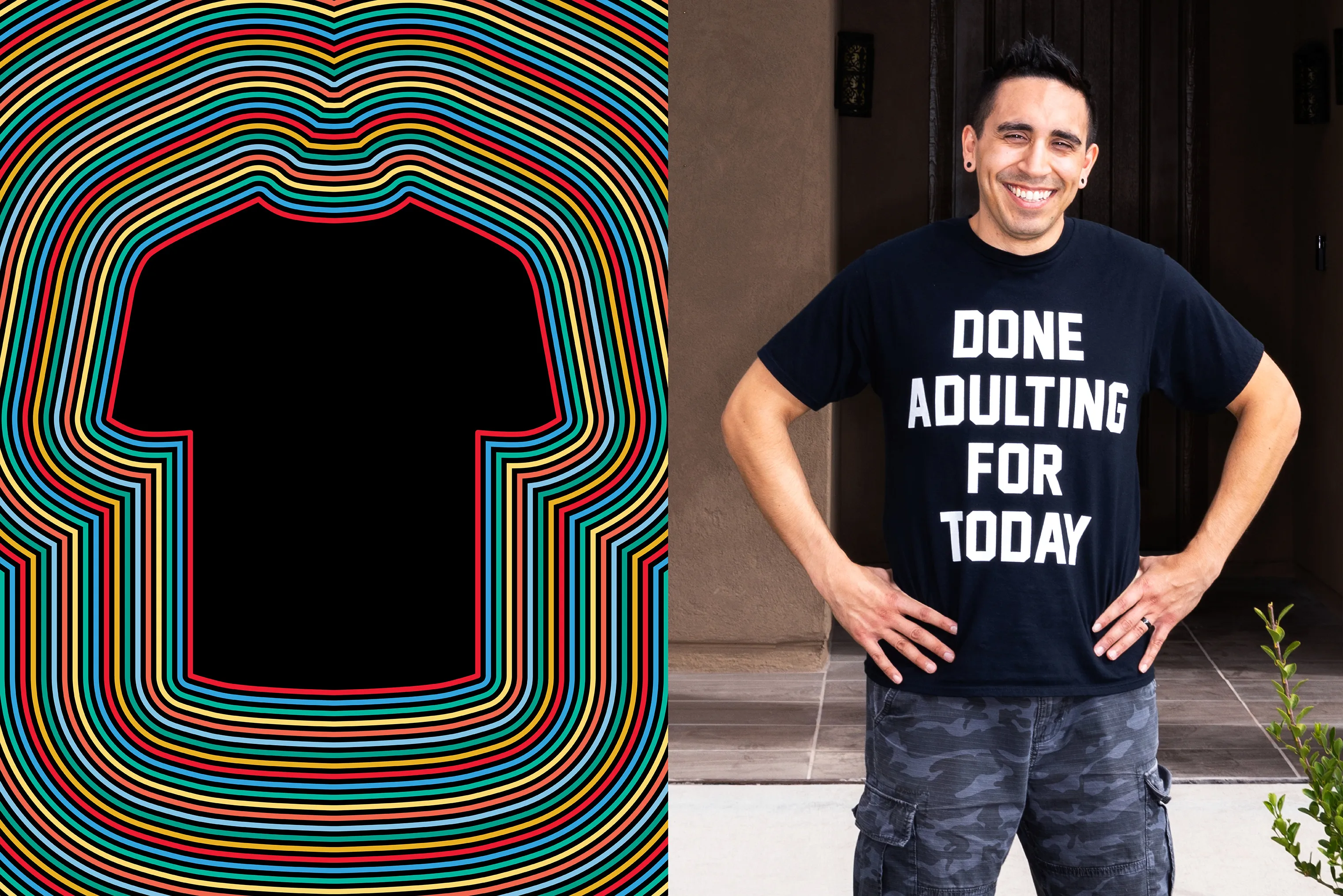Nearly every night after dinner for eight straight months, Glen Zubia brewed a cup of coffee, turned on heavy metal music, and made T-shirts.
On Mondays he did research, scouring the Internet for funny slogans, like the one where Santa Claus asks, “Where My Ho’s At?”
On Tuesdays and Wednesdays he designed in Adobe Illustrator. On Thursdays he saved his creations in the correct image format—a process that takes longer than you’d think—and on Fridays and Saturdays he uploaded them to Amazon.
Then, sending up a prayer that they’d sell, he started all over again.
“Idea, design, upload. Idea, design, upload,” the 32-year-old says of his life in 2015 and 2016. “I was designing as many as I could [and] spent from seven to midnight every day cranking those out.”
It was grueling, but it paid off. Eventually, Zubia had a 2,800-item catalog of designs, slogans, and illustrations online that people could purchase on T-shirts and hoodies. That work spurt earned him $120,000—enough to move out of his parents’ house and buy his own home in El Paso. Even more remarkable, he’s still pocketing roughly $3,000 a month today from those years-old designs.
Zubia is one of many average Americans who are tapping into what’s known as “passive income”—revenue streams that can generate cash for people who put in a bit of work at one moment in time, and then sit back and watch checks come in forever.
Also called print on demand, this method of passive income works differently than, say, renting out real estate or playing the stock market. The overhead is extremely low—sellers don’t have to worry about storing any inventory or making physical items. Companies like Teespring, Redbubble, and Merch by Amazon have sprung up this decade to fuel the passive income industry. Their sole function is to handle the logistics of printing and shipping while paying out design royalties to people like Zubia, whose bestsellers have said things like “Awesome Since 1978” and “Born in Chicago.”

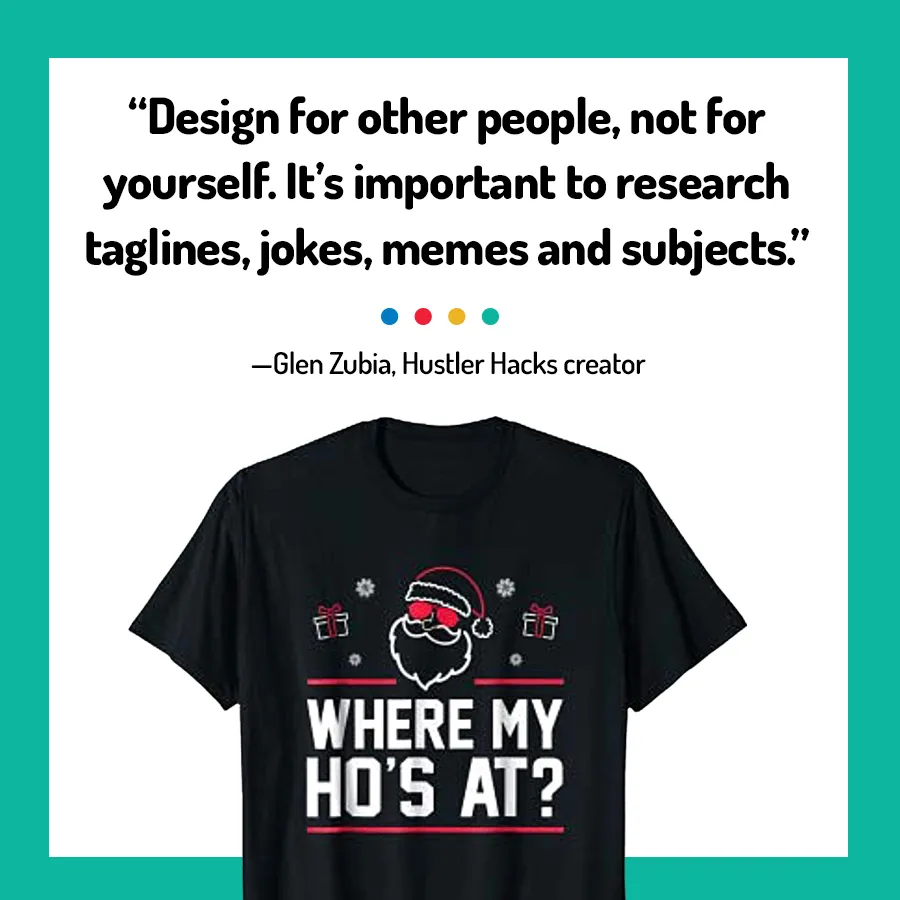
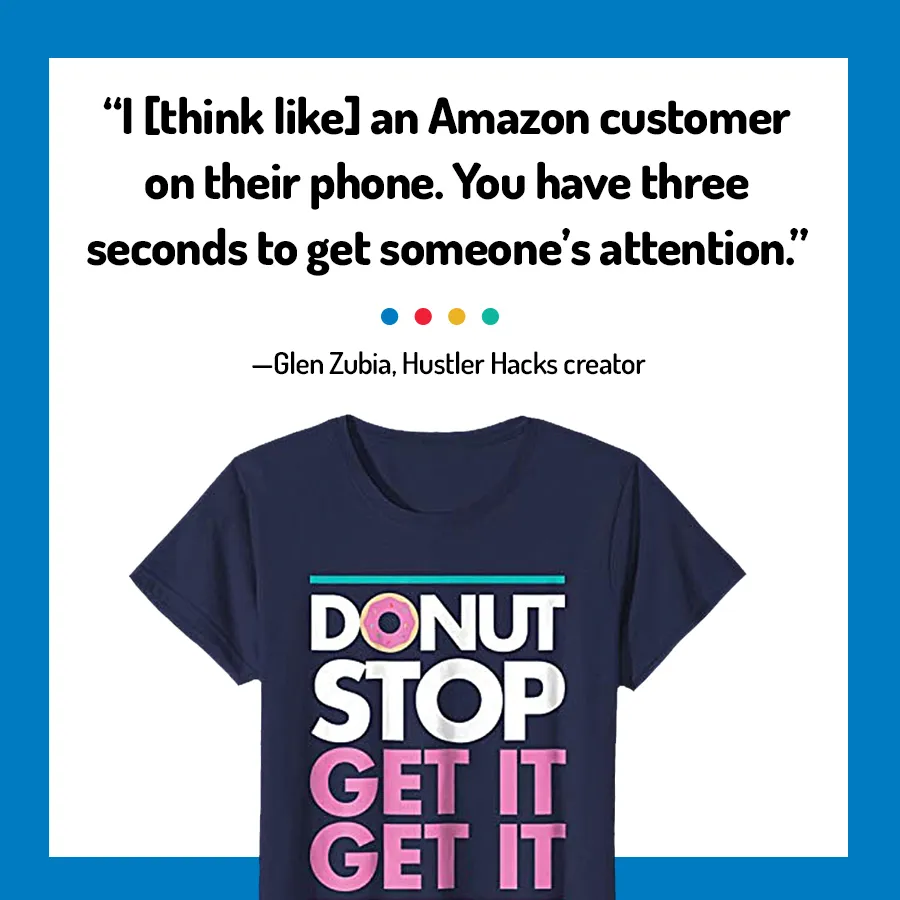
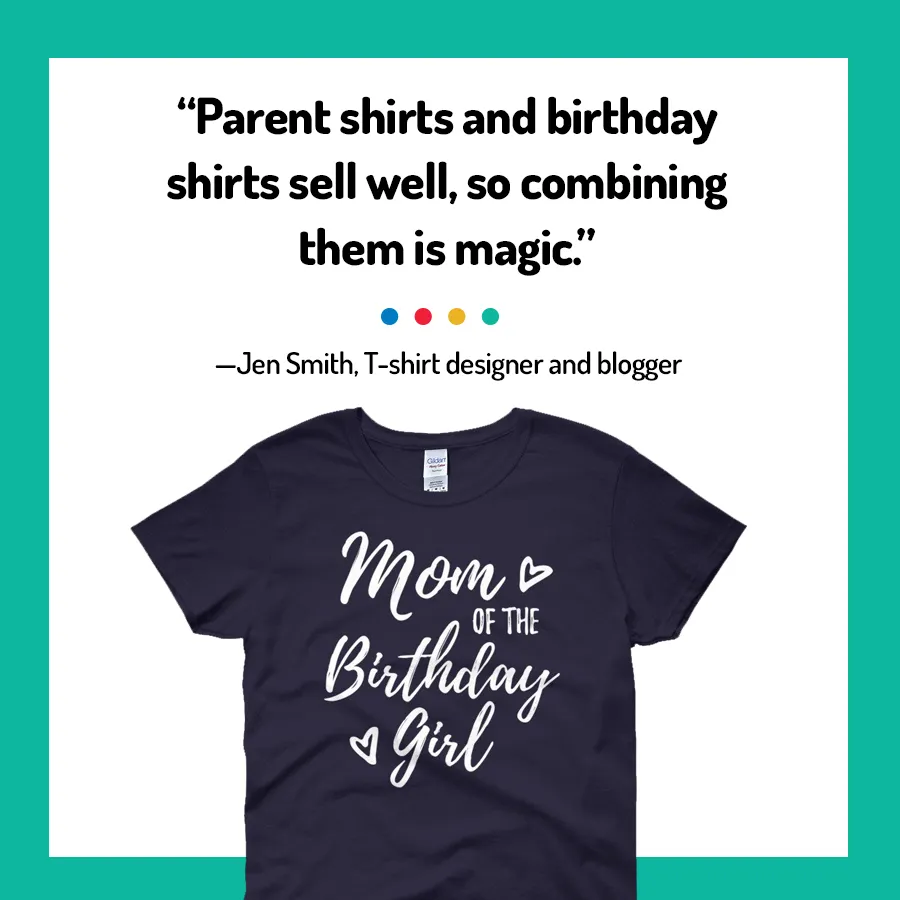
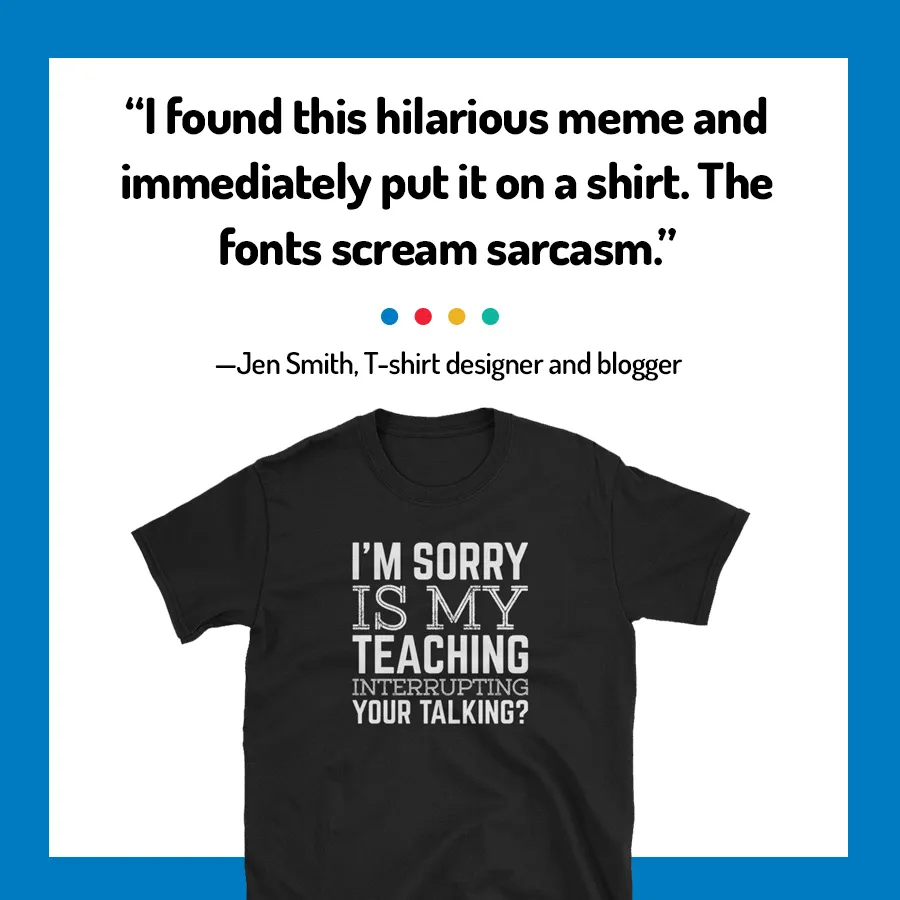
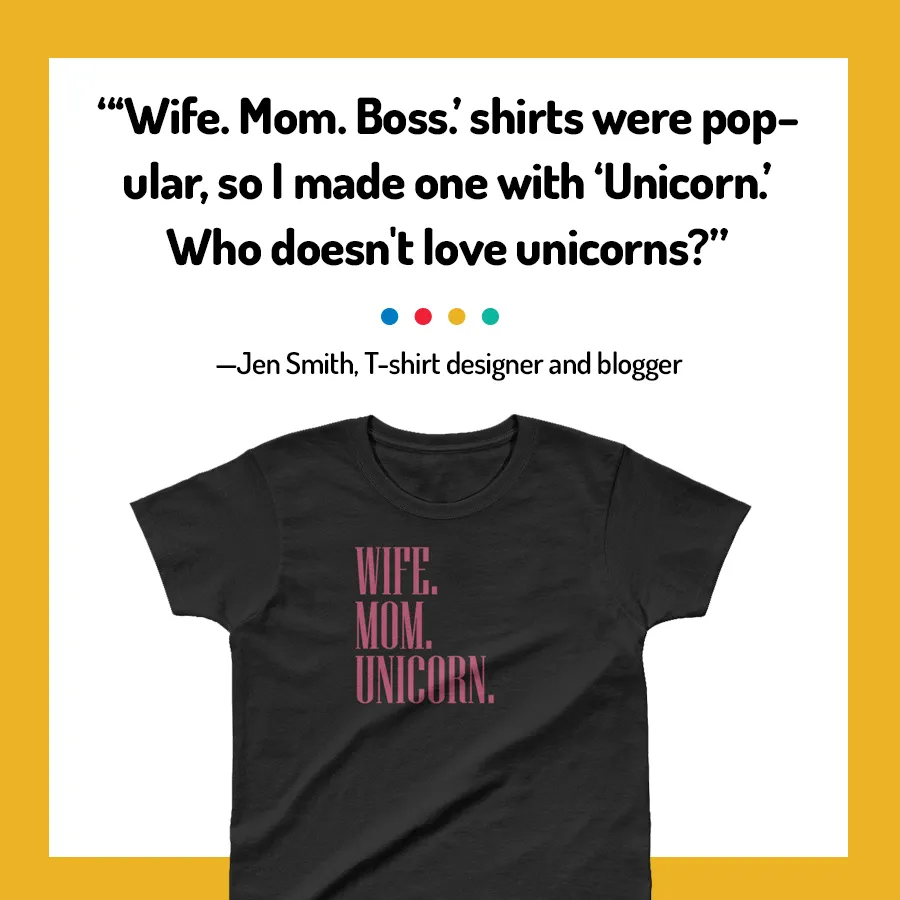
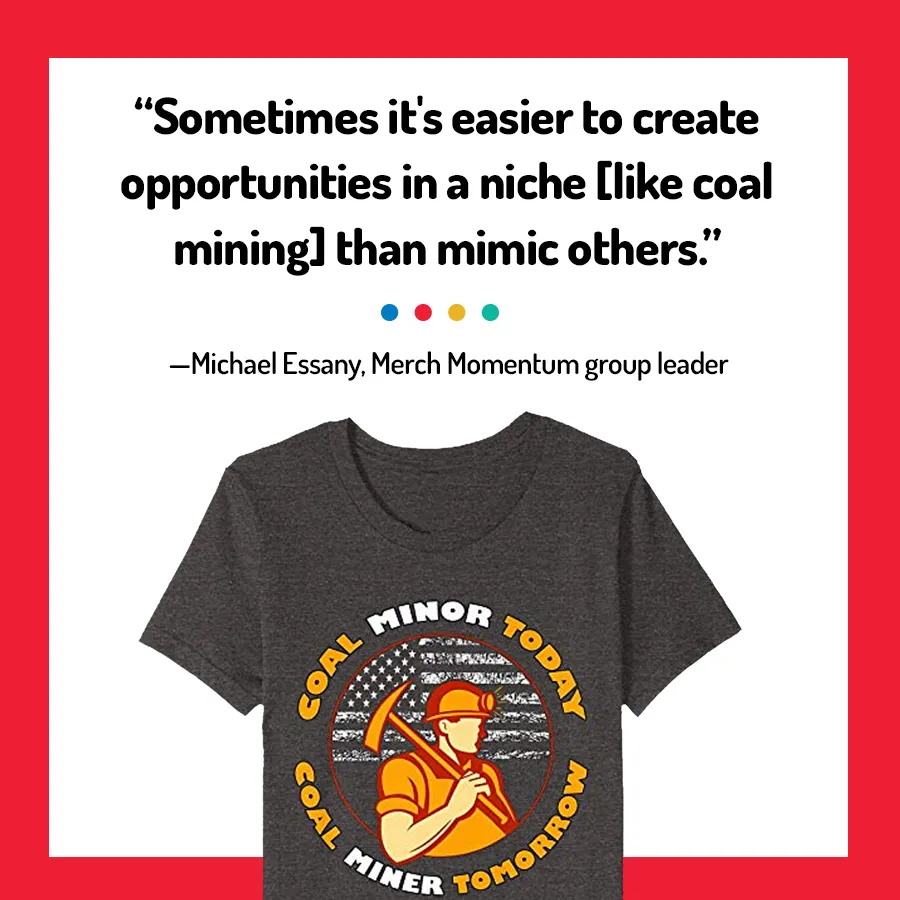
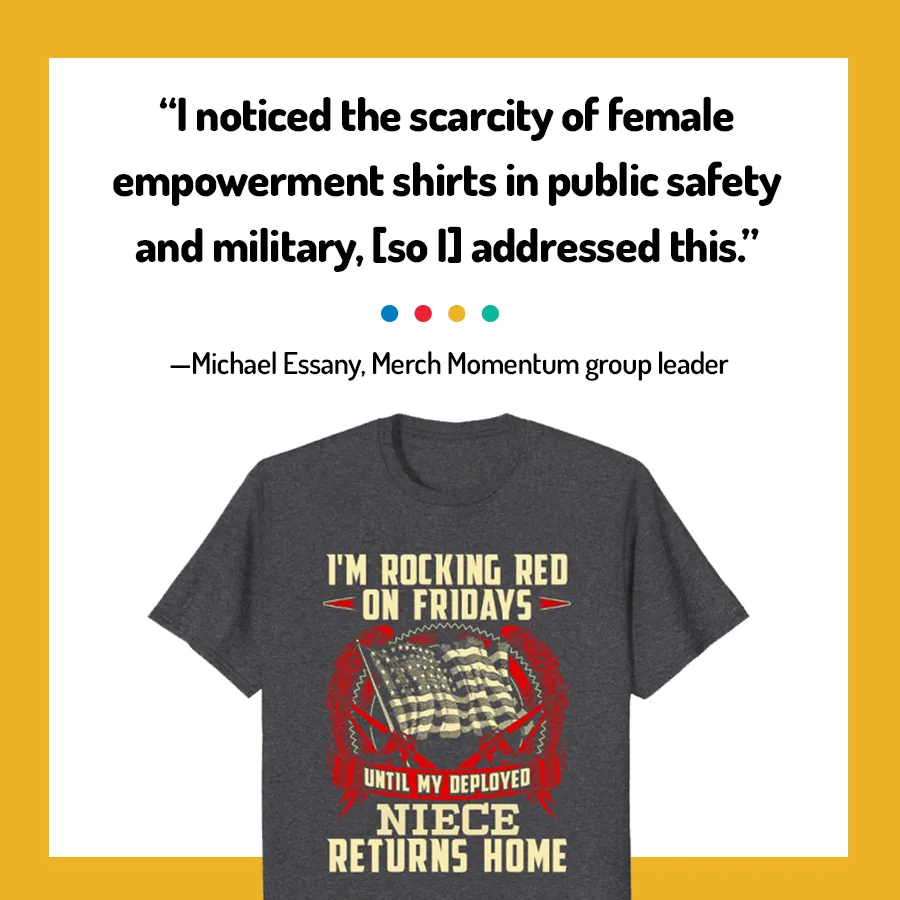

It’s so easy, anyone can do it. Say you take a scenic photo on vacation — a long-exposure image of the Fontaines de la Concorde in Paris, or maybe a shot of waves breaking on the shores of Waimea Bay in Oahu. Instead of letting it collect virtual dust on your desktop, you can upload it to one of these sites.
Now it’s ready for transfer onto mugs, stickers, tote bags, wall tapestries, and nearly any other item customers want your pretty picture on.
But striking it rich isn’t so simple. Turns out, the competition to make those T-shirts that always show up in search results—you know, the ones that say “Praying Is My Therapy” or “I’m Holding a Beer. So Yeah, I’m Pretty Busy”—is tough. You have to know how to play the game.
Zubia clearly does, even though he didn’t think he would ever be making thousands of dollars from selling T-shirts on the Internet. After earning a modest living in college selling custom action figures on eBay, he graduated with a graphic design degree and worked as a marketing coordinator. Student loan debt led him to pursue e-commerce, which in turn introduced him to Merch by Amazon.
“My instant thought was about just how many millions of people are shopping on Amazon,” he says. “It sounded too good to be true.”
For three months, Zubia didn’t earn any money from his sales. He caught a break in his fourth month, when he finally got a check for $107. That was his breakthrough moment. “I was like, ‘Okay, it’s getting somewhere. It’s possible. You can do this,’ ” he says.
Zubia quit his marketing job and now runs a YouTube channel called Hustler Hacks. He says passive income means he doesn’t have to have a storefront or handle angry customer emails and can instead focus on the creative side of the merch business, which also enables him to flex his graphic design skills. His favorite part is that he can make his own schedule.
There’s no denying that Zubia is a success story, but he’s also an outlier. More and more people are diving into the passive income world. So what is it? A lazy way for the masses to try to get rich quick, or a sophisticated business model for a select few?
The answer may just be a weird mix of both.
Kelsie Olds has sold more than 800 shirts and earned over $4,000 on Teespring since 2014—a decent amount of money for not much work.
But when the Tulsa-based seller became a mom about a year ago, she cut back on the number of illustrations she was uploading to her profile. Her listings, which included a series that paired cartoon animals with inspirational messages about Down syndrome, remained online.
Without touching her profile, and without the Facebook and Twitter marketing she used to do, the 23-year-old is still pocketing a few dollars a month. To Olds, the amount doesn’t matter; it’s basically free cash.
“They’re just out there,” she says. “If I can make an extra $20, it’s an extra $20. It’s a meal or grocery money or gas money.”
For Olds, passive income is a latent side hustle. But in general, the more you want to earn, the more difficult it is.
That’s long been the case for online entrepreneurs. Everyone has a Facebook friend or two entrenched in “network marketing” like LuLaRoe and Beachbody. Instagram is packed with sponsored content, a.k.a. #sponcon, and there are dozens of apps that pay people to take surveys. Ask anyone in that world, and they will surely tell you how hard it is to survive.
Print on demand (or simply “merch”), where passive income thrives, took about two decades to get off the ground. CafePress, an online gift shop that calls itself “the recognized pioneer of customizable products,” launched back in 1999, followed by Zazzle in 2005 and Redbubble in 2006. By 2007 the trend had caught on widely enough that the Washington Post referred to custom T-shirts as a “growing market” and CNET published a listicle of “20 rad T-shirt sites.” Society6 started in 2009, then Teespring in 2012, and Merch by Amazon in 2015.
Having so many options will help any passive income newbie maximize sales, but it’s Merch by Amazon that nets sellers the big bucks. It’s prestigious not only because it’s affiliated with a trillion-dollar company but also because it attracts so much traffic. According to Statista, Amazon.com got 2.6 billion visits worldwide in July 2018 alone. And because it’s so lofty, it takes a lot of elbow grease to become successful on Amazon.
The battle starts the moment sellers apply—yes, apply—for an account.
Nobody knows what Amazon is looking for in a Merch by Amazon member, and there’s no public timeline for how fast it responds to requests. Some people are approved within days; for others, it takes weeks.
Michael Essany, leader of the 11,000-member Facebook group Merch Momentum and a 36-year-old talk show host, urges patience. He says the merch account he made spontaneously in 2015 is “worth its weight in gold.”
“To me, graphic design was crayons on paper, playing with my children. When my first design sold, something clicked for me,” he says. “Within the span of 12 months, I had a low-six-figure annual-income business selling T-shirts.”
Once in, sellers have to quickly figure out their merch philosophy. Everyone has a different approach: Some people buy costly packages of generic designs from passive income experts and upload them, while others customize shirts themselves in knockoff Photoshop programs. Some look to the bestseller list for inspiration; others try to beat the crowds by experimenting with their own creativity.
Essany has gone particularly deep on passive income strategy. Instead of chasing trends, he dedicates time to market research. He surveys people using the platform Pollfish to find out which customers prefer what messages on their apparel—whether police officers like sarcastic shirts, for example, or teachers opt for serious ones—and creates accordingly. One of his most popular designs is a black T-shirt that says “Proud Union Operating Engineer—the Greatest Workers Are America’s Workers.”
Essany targets what he calls microniches, or underserved small audiences of customers. Instead of uploading a design that brags that the wearer is the wife of a firefighter, he creates one for the cousin. If everyone else is making shirts about bowling, he’ll post one for candlemaking.
Merch by Amazon sellers operate on a tier system. Once a person has uploaded 10 designs, she has to wait until she has 10 sales in order to add more. There’s tier 25, tier 100, tier 500, and so on.
Essany is tier 12,000. He spends about four hours a day on passive income—it’s his life now. “I can’t imagine not doing merch,” he says.
He isn’t alone in taking passive income extremely seriously. Because this constitutes many people’s livelihoods, they have a tendency to go a little overboard. For instance, a lot of print-on-demand sellers refuse to say what their most successful products are, for fear you’ll copy them. They’re constantly tweaking their product descriptions to maximize “long tail SEO.” They also pepper conversations with business jargon, talking about things like “lagging indicators” and name-dropping “Q4.” They’re especially fond of acronyms, abbreviating print on demand to “POD” and bestseller ranking to “BSR.”
Essany releases weekly strategy guides to a group of subscribers. In them, he helpfully details which categories are selling the best for him.
Recently, those included cryptocurrency shirts, science pun shirts, and Bigfoot food shirts, whatever those are.
Even when your strategy is smart, print on demand still has some unforeseen challenges, not the least of which is the fact that you’re relying on a mercurial corporation for a paycheck. In Amazon’s case, Jeff Bezos giveth and Jeff Bezos taketh away.
Jen Smith has seen both happen. The 29-year-old Florida-based seller discovered passive income when she and her husband were trying to pay off $78,000 in debt. They both got side gigs to make extra money, and she says she quickly learned “how much I hate working really low-paying hourly jobs.” Along with her print-on-demand income streams, she self-publishes personal finance books, sells advertisements for her blog, and rents out a room on Airbnb.
She was accepted to Merch by Amazon in May 2017. Smith says she thinks she made the cut because she has a blog, Saving With Spunk, which made her appear more professional. She uploaded a few shirts she made with the graphic design tool Canva, and got her first check. It was for $11.
“By the time I got to the 100 tier, I was able to make $450 and $700. Then I designed a few Halloween shirts the last year that just exploded. I went from $700 to $2,000 [a month],” she says.
Smith says her T-shirts are popular because they’re simple. She designs them around keywords, leaning more into analytics than art, and optimizes her listings.
Now debt-free, she used part of her passive income to buy an RV to flip and resell. The rest is in a designated savings account. “It’s like an extra emergency fund,” Smith says.
It has to be an additional, not primary, source of income because of Amazon’s volatility. During the past two winters, just as she and the rest of the passive community were gearing up for a holiday sales boom, Amazon started limiting uploads. Sellers say the company was overloaded with orders and didn’t have the bandwidth to make their shirts.
Revenue tumbled, and sellers were livid. Smith says she personally went from making $2,000 in October 2017 to $782 in December.
“Everyone was so angry. It taught me not to put all my eggs in the Amazon basket,” she says. “Amazon owns the customers and the printing, which is great, but you can’t fully rely on it.”
The passive income community now solemnly refers to this period as “the freeze.”
Smith recently encountered her own personal freeze. In September, Amazon deactivated her account after someone reported eight of her designs for trademark infringement. The shirts had movie quotes on them.
She appealed to Amazon, pointing out that other sellers have similar designs still up on the website, but the company would not reverse its decision. Though she still has Etsy, Smith calls the entire situation “a huge bummer.”
“I always had it in the back of my mind that it was a distinct possibility I could be terminated at any time,” she says. “Now all of the other things I had that were totally original ideas, I can’t sell those anymore [on Amazon]. The whole account is gone.”
Smith’s reality is a seller’s worst nightmare. The passive community is obsessed with trademarks; people are constantly talking about them.
Can you say “I heart avocados” on a T-shirt? (Yes.) What about “Yabba Dabba Doo”? (No.) “Just Do It”? (Obviously not.)
Trademark fever has turned merch Facebook groups like Essany’s into a lively forum on intellectual-property law, filled with questions about the various nuances of copyrights. Several groups have self-appointed trademark gurus who respond to these legal questions, often linking to PDFs or Google Docs where they’ve already patiently explained how to use sites like TMHunt to check for conflicts.
Pricing is another major concern. Sellers can’t go too low, because they won’t make any money, but they can’t go too high, because nobody will buy their stuff. Casey Berg, a 24-year-old Californian who sells mainly on Redbubble, says he typically marks his products 15% to 20% above base cost.
But Berg warns that the returns can be discouraging. On Amazon, for instance, if a vendor sells standard shirts for $15.99, he or she earns only $2.36 a pop.
“It’s important to remember that a lot of the sites are charging you for their infrastructure, so the margin you get is going to be tiny,” he says. “It’s not altogether different from paying for a booth at a fair.”
The final hurdle for sellers is marketing. Berg says he monitors his traffic with Google Analytics and advertises mainly through Reddit. He makes artwork from the maps of different cities, so every time he finishes a piece, he posts about it on the relevant city’s subreddit.
“Sales aren’t about the quality of your art. It’s about the quality of your marketing,” Berg says.
Because experimenting with print on demand requires so little investment and involves almost no risk, nearly anyone can do it. As more people catch on, it’s increasingly difficult to be successful. You can see this firsthand at Merch Momentum and numerous other passive income forums, which are being flooded with anxious posts from sellers wondering why they’re not getting sales.
Data shows that business on the corporate side certainly seems to be booming. Chris Lamontagne, vice president of commercial at Teespring, says his site’s 5 million sellers have earned more than $300 million since the company launched in 2012. The average seller pockets about $9,000 a year from the service. At least 30 people have become Teespring millionaires, and about 3,000 new sellers join the site every day—which he takes as a sign the passive income trend is just getting started.
“You’re the master of your own destiny at this point,” he says.
Other sites are making moves as well. Amazon’s merch program is growing: It opened up in Germany and the U.K. earlier this year, and it recently added PopSockets to its offerings.
Patrick FitzGerald, a lecturer at the University of Pennsylvania’s Wharton School, recommends all sellers have a backup plan in case their service of choice cuts them off.
“There is an old adage: Be careful where you build,” he says. “If you build on somebody else’s land, they always own that land. I don’t care how nice that house is you built. They can tear it down.”
FitzGerald is also concerned that websites, in handling all the nuts and bolts of print on demand, are preventing sellers from getting to know their customers—and therefore establishing a fan base.
For Spencer Shewbridge and Shannon Kempenich, who have a podcast called Merch Lifestyle, that’s the evolution they see in the passive income life. The friends are pivoting away from Merch by Amazon because they think they can build stronger brands if they get data on the people who buy their shirts.
In the meantime, both men are taking advantage of not being stuck in a cubicle. Kempenich, 33, took six months to hike the Appalachian Trail a few years ago, and he’s working to get his passive income to a level at which he feels comfortable enough to take a similarly long canoeing trip down the Mississippi River with his girlfriend.
Shewbridge, a 27-year-old living in the Bay Area, is aiming to earn $5,000 a month in profit from his geography- and hobby-themed shirts.
“The ultimate goal is to create a business that runs itself, that allows you to use your time in whatever way you want, without having to worry about money,” Shewbridge says. “We’re putting in the work upfront.”
